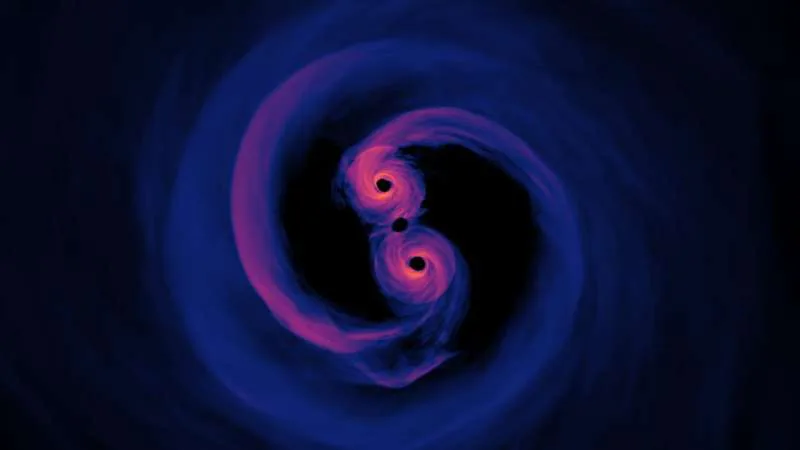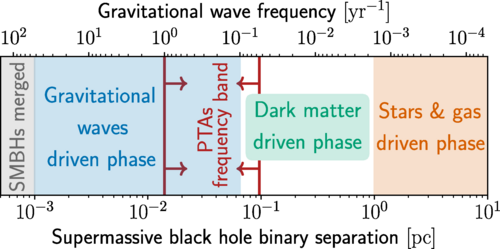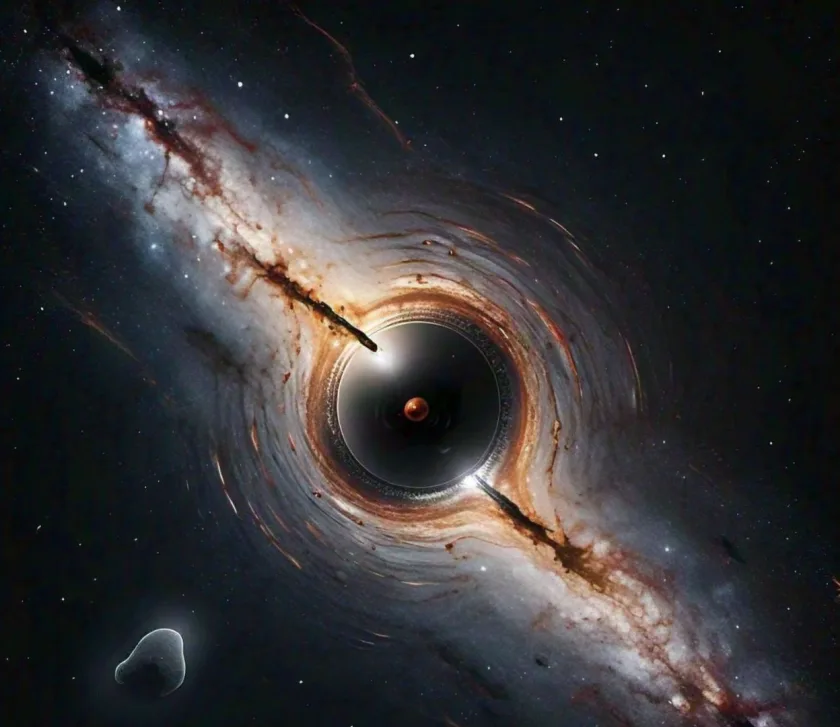
Launched in 1977, Voyager 1 is one of the farthest probes that we’ve sent so far. As of July 2024, it’s a whopping 24.4 billion kilometers away from Earth, making it the most distant human-made object ever. Yet, there are things in the space that we have absolutely zero clue. Yes, I’m referring to – Dark Matter.
Dark matter helps slow the black holes down and lets them come together for supermassive black hole mergers, at least the recent research says so. Typically elusive, this invisible matter seems to play a pivotal role in the celestial mergers.
Dark Matter May Be Key to Black Hole Mergers and Gravitational Wave Signals
Scientists are finding more evidence for random gravitational waves likely caused by the merging of very large black holes. When this dark matter is not involved, the black holes struggle to close the critical distance needed for merging. However, when the invisible matter interacts in a specific way, it facilitates the cosmic union.
It’s like two ice skaters on a frozen lake, trying to come together but continuously slowing down as they get close. Generally, in the presence of a push (external force) both the ice skaters can collide. But if the ice has enough friction, it can provide the necessary push for them to meet at the center. Similarly, the friction between their skates and the ice can be considered as the dark matter.
This intriguing theory aligns seamlessly with recent gravitational wave data, offering new insights into the mysterious behavior of dark matter on smaller scales. Could this be the clue we need to unlock the mysteries of our universe?

“Final Parsec Problem” Revisited
In 2023, astrophysicists made an exciting discovery, they detected a persistent “hum” of gravitational waves reverberating throughout the universe. They believed this signal came from millions of supermassive black hole (SMBH) pairs, each with a mass billions of times that of our sun, merging together.
However theoretical simulations revealed that as these colossal black holes spiral get close to one another, they encounter an anomaly. No sooner the spirals reach a particular proximity, their movement towards each other stalls. Thus, preventing them from merging. The proximity was equivalent to around three light years, also called as a parsec. Hence, the phenomenon is known as the “final parsec problem”.
This stalling issue posed a significant problem. If merging SMBHs couldn’t get past this final parsec, then there couldn’t be the source of the gravitational wave background as theorized. Additionally, it challenged the idea that SMBHs grow by merging with smaller black holes. Thus, the final parsec problem not only contradicted the hypothesis about the origin of the gravitational wave background but also questioned our understanding of how supermassive black holes evolve and grow.
Gonzalo Alonso-Álvarez, a researcher, explains that incorporating the impact of dark matter—which scientists previously didn’t consider—can facilitate the merger of supermassive black holes. His new calculations demonstrate how this process can occur, presenting a different perspective from previous theories.
New Research Reveals Dark Matter’s Role in Supermassive Black Hole Mergers
As per the scientists, supermassive black holes (SMBHs) are usually found in the middle of galaxies. So, when two galaxies crash into each other, their central black holes end up circling each other. The gravity from nearby stars pulls on these black holes, causing them to lose speed and move closer together until they eventually merge into one larger black hole.
Earlier models of how supermassive black holes (SMBHs) merge showed that when these black holes get very close to each other, about a parsec apart, they start to affect the dark matter around them. The strong gravitational forces from these black holes push the dark matter particles away. Because there’s less dark matter around, it means there’s less energy being drained from the two black holes. As a result, their orbits stop getting smaller, slowing down the merging process.
Previous models ignored how dark matter affects the paths of supermassive black holes (SMBHs). The new research by Alonso-Álvarez and his team shows that dark matter particles interact in a way that keeps them from spreading out. This means the dark matter stays dense enough to continue affecting the SMBHs, which eventually leads to the SMBHs merging together.

Persistent Gravitational Wave Hum Challenges Existing Theories
When huge objects in space crash into each other, they create a background noise made of long gravitational waves. These waves are different from the shorter gravitational waves that scientists first found in 2015 using a special tool called LIGO, which happened when two black holes, each 30 times heavier than the sun, merged.
Scientists have picked up a persistent hum using a technology called the Pulsar Timing Array. This technology helps detect gravitational waves by closely observing small changes in the signals from pulsars. Pulsars are fast-spinning neutron stars that send out strong radio signals.
Professor James Cline from McGill University and the CERN Theoretical Physics Department in Switzerland stated that their theory suggests fewer strong gravitational waves should be observed at low frequencies when using pulsar timing arrays. This means that the persistent hum they detected might not align with their current understanding of gravitational wave sources. Thus, to explain these observations, the need of the hour is to revise existing theories or consider new factors, such as
- the influence of dark matter or
- other astrophysical phenomena
Takeaway
The research highlights an important role that dark matter plays in the merging of supermassive black holes. By showing how dark matter’s interactions can influence the merging process of SMBHs, researchers can infer properties about dark matter, such as its distribution, density, and interaction strengths.
To better understand this, advancements in technology and methods for detecting gravitational waves will be crucial for resolving discrepancies and improving the accuracy of measurements. After all, the new findings could reshape our existing theories about how supermassive black holes evolve and merge. And over all, it’ll affect our understanding of galaxy formation and cosmic structure.
Via: Physics Magazine



